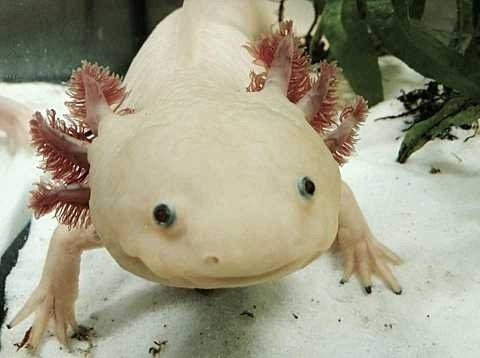( )
)
The axolotl also is known as the Mexican walking fish, is a neotenic salamander related to the tiger salamander. Although the axolotl is colloquially known as a "walking fish", it is not a fish, but an amphibian. The species was originally found in several lakes, such as Lake Xochimilco underlying Mexico City. Axolotls are unusual among amphibians in that they reach adulthood without undergoing metamorphosis. Instead of developing lungs and taking to the land, adults remain aquatic and gilled.
Axolotls should not be confused with waterdogs, the larval stage of the closely related tiger salamanders which are widespread in much of North America and occasionally become neotenic. Neither should they be confused with mudpuppies (Necturus spp.), fully aquatic salamanders that are not closely related to the axolotl but bear a superficial resemblance.
Regeneration
The feature of the salamander that attracts the most attention is its healing ability: the axolotl does not heal by scarring and is capable of the regeneration of entire lost appendages in a period of months, and, in certain cases, more vital structures. Some have indeed been found restoring the less vital parts of their brains. They can also readily accept transplants from other individuals, including eyes and parts of the brain—restoring these alien organs to full functionality. In some cases, axolotls have been known to repair a damaged limb, as well as regenerating an additional one, ending up with an extra appendage that makes them attractive to pet owners as a novelty. In metamorphosed individuals, however, the ability to regenerate is greatly diminished. The axolotl is therefore used as a model for the development of limbs invertebrates.
The axolotl is only native to Lake Xochimilco and Lake Chalco in the Valley of Mexico. Lake Chalco no longer exists, having been drained as a flood control measure, and Lake Xochimilco remains a remnant of its former self, existing mainly as canals. The water temperature in Xochimilco rarely rises above 20 °C (68 °F), though it may fall to 6 to 7 °C in the winter, and perhaps lower.
Today, the axolotl is still used in research as a model organism, and large numbers are bred in captivity. They are especially easy to breed compared to other salamanders in their family, which are almost never captive-bred due to the demands of terrestrial life
Entra a la lista de tag para que escojas las más apropiadas dándole click aquí.
Puedes indagar algo más sobre las etiquetas entrando por https://steemit.com/trending/ y agregando después de la barra oblicua ( / ) la palabra que desees usar como etiqueta para ver si existe.
En este post puedes leer algo más sobre el uso apropiado de las etiquetas.
Entra al post sobre Mensajes Educativos ya que te puede interesar
Downvoting a post can decrease pending rewards and make it less visible. Common reasons:
Submit
Muchas gracias por el aporte lo consideraré :)
Downvoting a post can decrease pending rewards and make it less visible. Common reasons:
Submit
Nature is amazing! i invite you to pass into my blog. you may be interested in my content
Downvoting a post can decrease pending rewards and make it less visible. Common reasons:
Submit
Thank you very much, it'd be a pleasure :)
Downvoting a post can decrease pending rewards and make it less visible. Common reasons:
Submit
Hi! I am a robot. I just upvoted you! I found similar content that readers might be interested in:
https://rareanimalsintheworld.blogspot.com/2012/07/axolotl.html
Downvoting a post can decrease pending rewards and make it less visible. Common reasons:
Submit